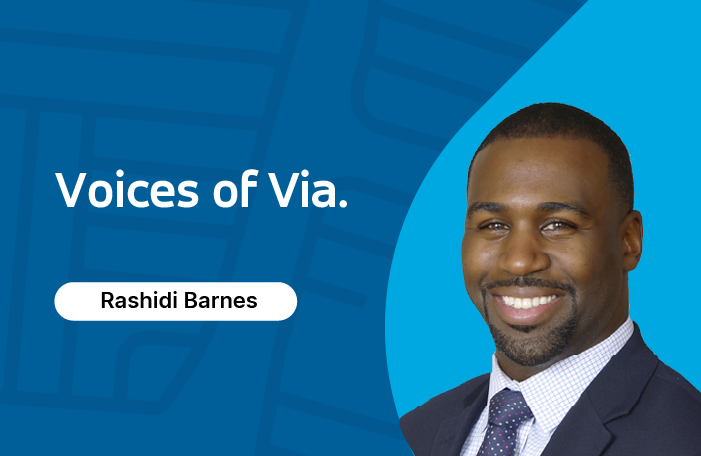Recommended reading: Want to back up and meet some more innovative transit leaders? Read our “Voices of Via and Remix” series.
Spotlight on: Rashidi Barnes, CEO of Eastern Contra Costa Transit Authority (ECCTA), known as Tri Delta Transit, in Antioch, California. Barnes started his career 20 years ago at Transit Marketing Group as a regional sales manager, and has seen his career grow in the public sector. From 2012 to 2018, he worked at Central Contra Costa Transit Authority (CCCTA), holding roles including senior manager of transportation, senior manager of innovation and shared mobility, and director of innovation and shared mobility. In 2015, Barnes was awarded 40 Under 40 in Mass Transit magazine for his contribution to bringing innovative service to the local communities. After CCCTA, he served as First Transit’s Director of Mobility as a Service for four and half years.
In September 2022, he was nominated as ECCTA’s CEO in recognition of his years of dedication to innovating public transit and experience in collaborating with a wide range of entities — transit agencies, transportation networking firms, payment providers, and micro-mobility services — to offer comprehensive transportation solutions.
You started your career in the private sector almost 20 years ago, transitioned to the public side, went back to school for academic training, and have been working in the public sector for many years. How does that experience shape your view on building better transportation?
RB: I always joke about this — I'm probably one of the only CEOs who has actually been underneath the bus or inspected a fire detection system or replaced a cantilever passenger seat. I value that experience. Understanding how capital assets like train cars and buses are constructed, procured and operated helped to create a baseline knowledge of our industry that I have built off of for years.
To your point about my academic experience, graduating with my Masters from the Mineta Transportation Institute, allowed me to build relationships with other key members of this industry, while working alongside them through graduate-level studies. The same can be said for during my time in Leadership APTA and ENO’s Executive Management program. These programs were key to my development and helped me understand transportation from a holistic view.
People I have met through these programs have all been mentors to me and friends I can reach back to even 20 years later. They answer my call when I have a problem in maintenance or with operations. The friendship/mentorship allows me to better understand what's going on outside of my little world. So having those relationships and leveraging them has been key to my success in this industry.
What would you say are the challenges and opportunities that ECCTA faces right now?
RB: With our agency being a legacy system, we haven't really been outside of our world, so a lot of the technologies that we use are antiquated. To broaden our world, everyone is encouraged to venture out to observe new trends and technologies used by our partners, other cities, and transit agencies in California.
There are a few other challenges we’re dealing with, such as our fiscal cliff, ridership not rebounding in the region, and changes in travel trends. Challenges are often in addition to the heavy workload transit has, so we are tackling one issue at a time.
I preach to our staff all the time that your mental health is more important to me than doing a perfect job on a regular basis. I want to make sure that the staff takes their time off when they need it because I understand we can't move forward if they are not in the right mental space when dealing with complicated tasks daily.
A few years ago, ECCTA selected Via as the new technology provider for the TriMyRide microtransit service. What benefits or advantages have you seen by using Via’s microtransit software?
RB: Before using Via’s operation system, we did not really have the capacity to understand a rider's daily changing travel trends. Now with the data that Via is providing us, we've been able to make some educated decisions to better meet riders’ changing travel demand with the complementary microtransit service. Monthly microtransit ridership has grown from 750, when the service was first launched, to over 10,000 now. And our utilization rate is up as well, reaching 5.4 — which is tremendously high for this operation.
Beyond just serving commuters, TriMyRide has been a great tool for some untraditional users such as parents who would traditionally otherwise pick up or drop off their children at school, for example. Rather than getting into normal school traffic, parents can just get on their phone, book the trip for their child, and get them to their location. The technology also lets them know when the child has been dropped off or picked up.
What’s the impact that Remix has had on your team? How has it changed how you’ve worked or planned?
RB: Remix has allowed us to more easily digest data. I can build a new line or zone easily and see what type of demographic will be impacted by it. Having that information at my fingertips is invaluable because I don’t have to look at three or four different periodicals to gather information on the different demographics for one specific area. Now with Remix, we have different data layers that show almost every geographical stat needed to understand an area. It helps us make well-informed, data-driven decisions on what a new service or changes in service could look like.
Are there any specific data layers that you personally find very helpful for optimizing the system?
RB: We're in a predominantly low-income area, so I look at poverty rates, incomes, and various demographics to ensure an equitable service is being considered.
As cities and transit agencies expand their private and public partnerships, what suggestions would you give to city leaders for smoother collaboration and communication with the private sector?
RB: I believe that smaller cities and municipalities are most likely going to start moving towards a model where they're not self-operating services. In the long run, smaller cities facing financial challenges may eliminate their transportation departments to reduce costs and increase operational efficiency. They'll begin contracting out services to vendors like Via, or others, which could include introducing microtransit or ridesharing services as an alternative transportation option. You have seen this model play out in cities like Arlington, Texas.
What is your next big goal for ECCTA?
RB: We foresee some funding issues, not just for the Bay Area, but throughout California. So, that is one of my major focuses this year — stabilizing funding and potentially identifying a regular funding source to support our transit operations for years to come.
Regarding our services, we will be issuing an RFP this year to help us complete a COA. This will help us set our service priorities as we evaluate all service models that may benefit Eastern Contra Costa County.

Data Journalist




%206.png?width=71&height=47&name=The%20Buzz%20Blog%20Hero%20(1750%20x%201200%20px)%206.png)